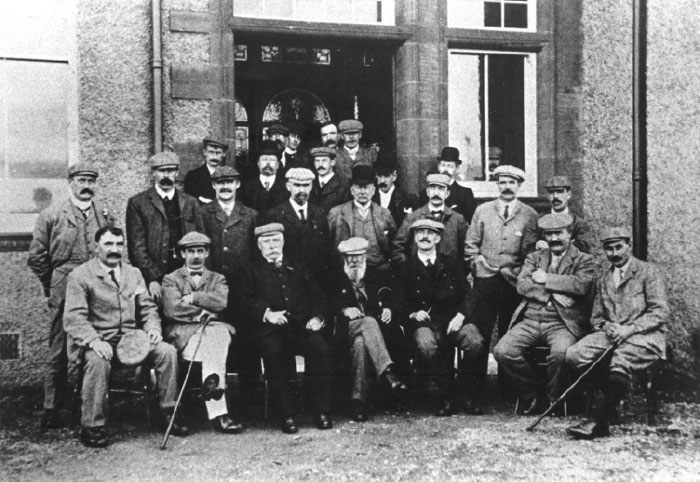- Course is open. Full Greens.




History of The Irvine Golf Club
The Irvine Golf Club is no stranger to famous players and professional tournaments, playing host to the R&A for the Local Open qualifying when the Open is held at near neighbours, Royal Troon or Trump Turnberry.
However, the photograph below, which is proudly on display in the club house shows the club playing host to an early professional tournament in 1904. Pictured in the centre is “Old” Tom Morris, pioneer of professional golf and in the 2nd row, second from the left is a young James Braid, who later went on to re-design the course in 1926.


Famous poet and playwright Robert H.C. Browning (1812-1889) was so impressed with the Irvine Golf Club that he published a historic guide to the course, in which he sums up:
“Time cannot wither it,
Nor Custom stale
Its Infinite Variety.”
Modern History
The club is famous for having reared three Scottish Champions who all grew up a stone’s throw from the course, in the former mining village of Bartonholm and the club today has a thriving junior section, so we hope we might have future Scottish Champions to come.
Pictured below is one of the club’s young talents, Stuart Easton.
Stuart took part in a unique Captains’ Challenge at Gleneagles, to mark a year to go to the Ryder Cup taking place at Gleneagles in September 2014. Not only did Stuart get the opportunity to meet golfing legend, Tom Watson, and winning European Captain, Paul McGinley, he also won a pair of tickets to the opening day of the Ryder Cup, courtesy of defeating Captain’s Watson and McGinley in the “closest to the hole” challenge.

The Irvine Golf Club, a stunning links golf experience
Set in a seaside location, the neighbouring Gulf Stream ensures year round links golf, whilst the romantic peaks of Arran present a stunning backdrop to the landscape.
It was over the links land of Scotland that the game of golf was born and still today the true links experience is unparalleled the world over.
The Irvine Golf Club established 1887, is a fine example and is regularly used by the R&A as a Final Open Qualifying Course. In 2003, the Club co-hosted the Amateur Championship with Royal Troon and in 2007, the British Seniors' Open with Turnberry. In 2009, the Ladies Home Internationals were also successfully hosted at the Irvine Golf Club. In 2016 we hosted the Scottish Youths Championship and the Ladies British Open Final Qualifying was also held at the club in 2017. This year 2024 we are proud to be hosting The Scottish Boys Championships in April.
It truly is one of Scotland’s hidden gems, offering a traditional links challenge, which owes much of its present day character to the course design of the great James Braid. One of Scotland’s most celebrated course designers, James Braid created a legacy of distinctive courses, characterised by their great variety and interesting use of nature’s assets. View our course image gallery.
The Irvine Golf Club, a stunning links golf experience
Set in a seaside location, the neighbouring Gulf Stream ensures year round links golf, whilst the romantic peaks of Arran present a stunning backdrop to the landscape.
It was over the links land of Scotland that the game of golf was born and still today the true links experience is unparalleled the world over.
The Irvine Golf Club established 1887, is a fine example and is regularly used by the R&A as a Final Open Qualifying Course. In 2003, the Club co-hosted the Amateur Championship with Royal Troon and in 2007, the British Seniors' Open with Turnberry. In 2009, the Ladies Home Internationals were also successfully hosted at the Irvine Golf Club. In 2016 we hosted the Scottish Youths Championship and the Ladies British Open Final Qualifying was also held at the club in 2017. In April 2024 the Scottish Boys Championships were held attracting a record entry from all over Europe.
It truly is one of Scotland’s hidden gems, offering a traditional links challenge, which owes much of its present day character to the course design of the great James Braid. One of Scotland’s most celebrated course designers, James Braid created a legacy of distinctive courses, characterised by their great variety and interesting use of nature’s assets. View our course image gallery.
It's easy to get started creating your website. Knowing some of the basics will help.
What is a Content Management System?
A content management system is software that allows you to create and manage webpages easily by separating the creation of your content from the mechanics required to present it on the web.
In this site, the content is stored in a database. The look and feel are created by a template. Joomla! brings together the template and your content to create web pages.
Logging in
To login to your site use the user name and password that were created as part of the installation process. Once logged-in you will be able to create and edit articles and modify some settings.
Creating an article
Once you are logged-in, a new menu will be visible. To create a new article, click on the "Submit Article" link on that menu.
The new article interface gives you a lot of options, but all you need to do is add a title and put something in the content area. To make it easy to find, set the state to published.
You can edit an existing article by clicking on the edit icon (this only displays to users who have the right to edit).
Template, site settings, and modules
The look and feel of your site is controlled by a template. You can change the site name, background colour, highlights colour and more by editing the template settings. Click the "Template Settings" in the user menu.Â
The boxes around the main content of the site are called modules. Â You can modify modules on the current page by moving your cursor to the module and clicking the edit link. Always be sure to save and close any module you edit.
You can change some site settings such as the site name and description by clicking on the "Site Settings" link.
More advanced options for templates, site settings, modules, and more are available in the site administrator.
Site and Administrator
Your site actually has two separate sites. The site (also called the front end) is what visitors to your site will see. The administrator (also called the back end) is only used by people managing your site. You can access the administrator by clicking the "Site Administrator" link on the "User Menu" menu (visible once you login) or by adding /administrator to the end of your domain name. The same user name and password are used for both sites.
Learn more
There is much more to learn about how to use Joomla! to create the web site you envision. You can learn much more at the Joomla! documentation site and on the Joomla! forums.





